Soundproofing sealants are essential for minimizing sound transmission in residential spaces, with options like acoustic caulk, silicone, polyurethane, and latex sealants each offering distinct advantages. Proper application techniques, including thorough surface preparation and allowing sufficient drying time, are crucial for maximizing their effectiveness. Avoiding common mistakes, such as inadequate cleaning and improper sealant selection, can significantly enhance the overall soundproofing results.
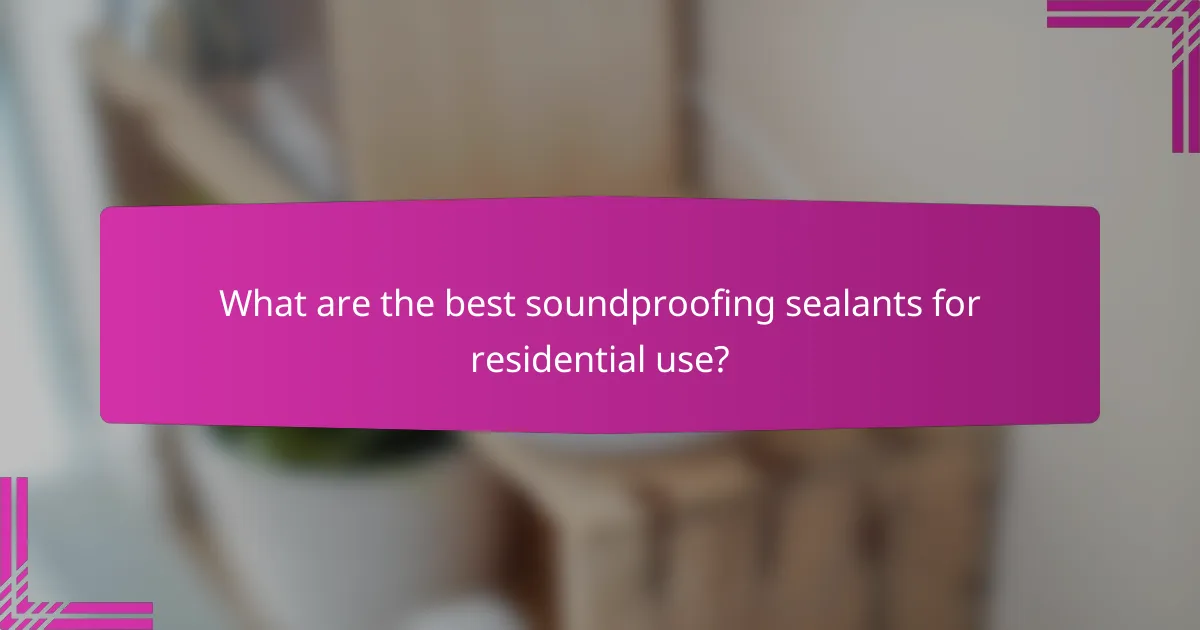
What are the best soundproofing sealants for residential use?
The best soundproofing sealants for residential use include acoustic caulk, silicone sealant, polyurethane sealant, and latex sealant. Each type offers unique properties that can effectively reduce sound transmission when applied correctly.
Acoustic Caulk
Acoustic caulk is specifically designed to block sound and is ideal for sealing gaps and cracks in walls, ceilings, and floors. It remains flexible after curing, allowing it to absorb vibrations and prevent sound leakage.
When applying acoustic caulk, ensure the surfaces are clean and dry. Use a caulking gun for precise application, filling gaps completely without leaving air pockets. Avoid over-applying, as it can lead to messy finishes.
Silicone Sealant
Silicone sealant is known for its durability and flexibility, making it suitable for soundproofing in areas exposed to moisture, such as bathrooms and kitchens. It adheres well to various surfaces, including glass, metal, and wood.
Choose a high-quality, acoustically rated silicone for optimal soundproofing. Apply it in a continuous bead and smooth it out with a tool or your finger to ensure a tight seal. Allow sufficient curing time as indicated by the manufacturer before painting or covering.
Polyurethane Sealant
Polyurethane sealant provides excellent adhesion and is highly resistant to weathering, making it effective for outdoor applications as well. It expands slightly upon curing, which helps fill larger gaps effectively.
While applying polyurethane sealant, wear gloves to protect your skin, as it can be difficult to remove once cured. Ensure proper ventilation during application, as the fumes can be strong. Allow for a longer curing time compared to other sealants.
Latex Sealant
Latex sealant is easy to apply and clean up, making it a popular choice for DIY projects. It is paintable and suitable for indoor applications, although it may not provide the same level of soundproofing as other sealants.
When using latex sealant, apply it generously to fill gaps and smooth it with a wet finger or tool. It dries quickly, so work in small sections to avoid issues with skinning over. Check for compatibility with the surfaces you are sealing to ensure effective adhesion.
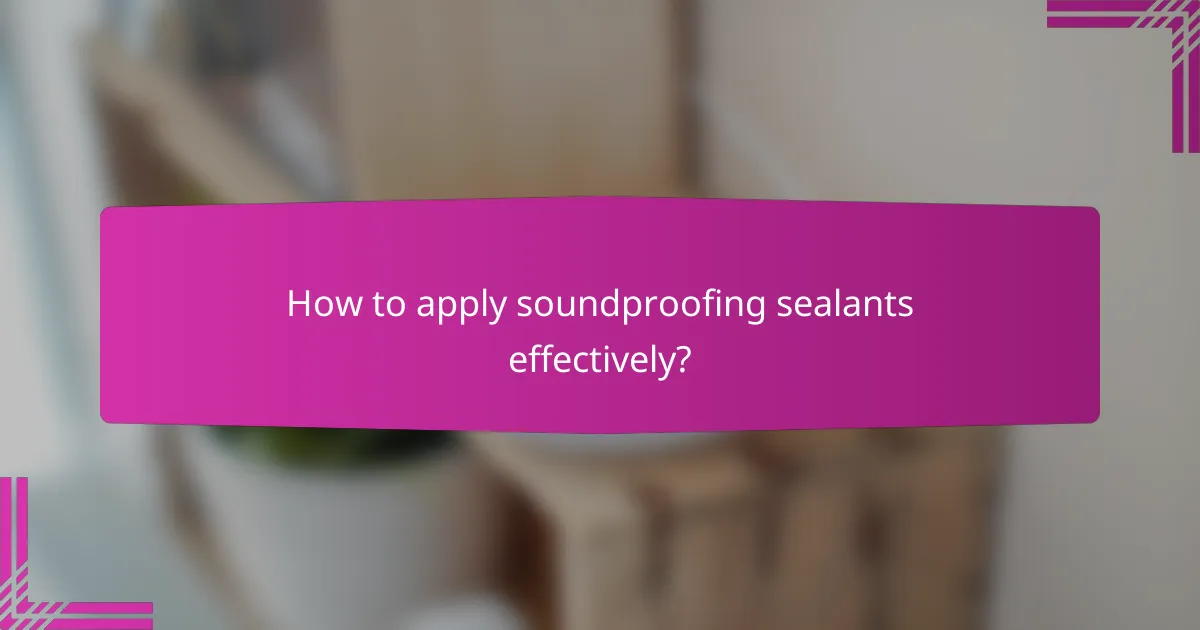
How to apply soundproofing sealants effectively?
To apply soundproofing sealants effectively, ensure proper surface preparation, use appropriate application techniques, and allow adequate drying and curing times. Following these steps will maximize the sealant’s soundproofing performance and longevity.
Surface Preparation
Surface preparation is crucial for the effective application of soundproofing sealants. Start by cleaning the surfaces to remove dust, grease, and debris, which can hinder adhesion. Use a suitable cleaner and allow the area to dry completely before proceeding.
Next, inspect the surfaces for any cracks or holes that need filling. For optimal results, consider sanding rough areas to create a smooth surface for the sealant to adhere to. This step helps ensure a tight seal that enhances soundproofing.
Application Techniques
When applying soundproofing sealants, use a caulking gun for precision and control. Apply the sealant in a continuous bead, ensuring it fills any gaps or cracks thoroughly. Maintain a steady hand to avoid uneven application, which can compromise effectiveness.
For larger areas, consider using a trowel or putty knife to spread the sealant evenly. This technique can help achieve a smooth finish and ensure complete coverage. Always follow the manufacturer’s instructions regarding thickness and layering for best results.
Drying and Curing Times
Drying and curing times for soundproofing sealants can vary based on the product and environmental conditions. Generally, allow the sealant to dry for several hours before exposing it to moisture or stress. Full curing may take anywhere from a day to a week, depending on factors like humidity and temperature.
To ensure optimal performance, check the product label for specific drying and curing recommendations. Avoid painting or covering the sealant until it is fully cured to maintain its soundproofing properties.
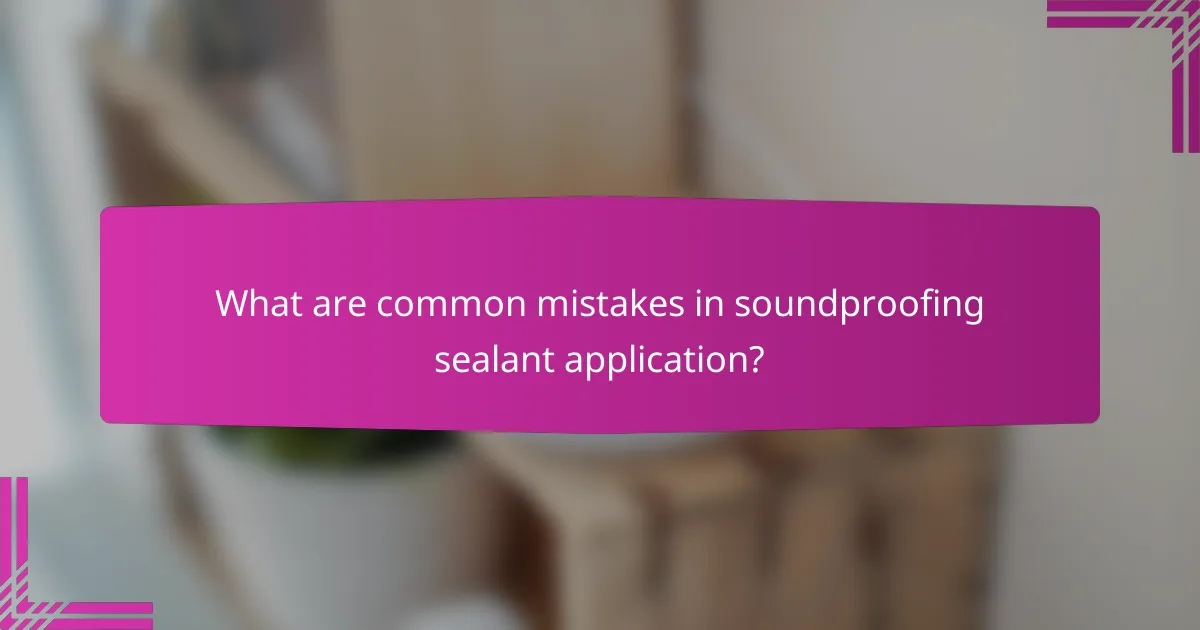
What are common mistakes in soundproofing sealant application?
Common mistakes in soundproofing sealant application include insufficient surface cleaning, improper sealant choice, and neglecting expansion gaps. These errors can significantly reduce the effectiveness of soundproofing efforts, leading to unsatisfactory results.
Insufficient Surface Cleaning
Before applying soundproofing sealants, it’s crucial to clean the surfaces thoroughly. Dust, grease, or old paint can prevent proper adhesion, leading to gaps and reduced soundproofing effectiveness.
To ensure optimal results, use a suitable cleaner and allow surfaces to dry completely before application. A clean surface enhances the bond of the sealant, maximizing its soundproofing capabilities.
Improper Sealant Choice
Selecting the right type of sealant is vital for effective soundproofing. Not all sealants are designed for acoustic applications; some may not provide the necessary density or flexibility.
For soundproofing, look for sealants specifically labeled as acoustic or sound-dampening. These products are formulated to absorb sound waves and minimize transmission, making them more effective than standard caulks or adhesives.
Neglecting Expansion Gaps
Ignoring expansion gaps can lead to structural issues and compromised soundproofing. Sealants need space to expand and contract with temperature changes; failing to account for this can result in cracks and gaps over time.
When applying sealants, ensure you leave adequate expansion gaps, especially in areas subject to movement, such as around windows and doors. This practice helps maintain the integrity of the seal and enhances overall soundproofing performance.

How do soundproofing sealants compare to other methods?
Soundproofing sealants offer a unique advantage by effectively sealing gaps and cracks that allow sound to penetrate, which is different from other soundproofing methods. While they are not a standalone solution, they complement techniques like acoustic panels and soundproofing foam by enhancing overall sound isolation.
Sealants vs. Acoustic Panels
Acoustic panels are designed to absorb sound waves, reducing echo and improving sound quality in a space. In contrast, soundproofing sealants focus on blocking sound transmission through gaps and joints. For optimal results, use sealants in conjunction with acoustic panels to address both sound absorption and sound leakage.
When considering application, acoustic panels require proper placement on walls or ceilings, while sealants can be applied easily to seams and edges. This makes sealants a quicker and often less expensive option for enhancing soundproofing in existing structures.
Sealants vs. Soundproofing Foam
Soundproofing foam is primarily used to absorb sound, similar to acoustic panels, but it may not effectively seal gaps. Sealants, on the other hand, are specifically formulated to fill voids and prevent sound from passing through. This makes them essential for achieving a comprehensive soundproofing strategy.
In terms of installation, soundproofing foam typically requires more effort to mount and may need to be replaced over time, while sealants can be applied quickly and last for years. For best results, consider using both products together to maximize sound isolation in your space.
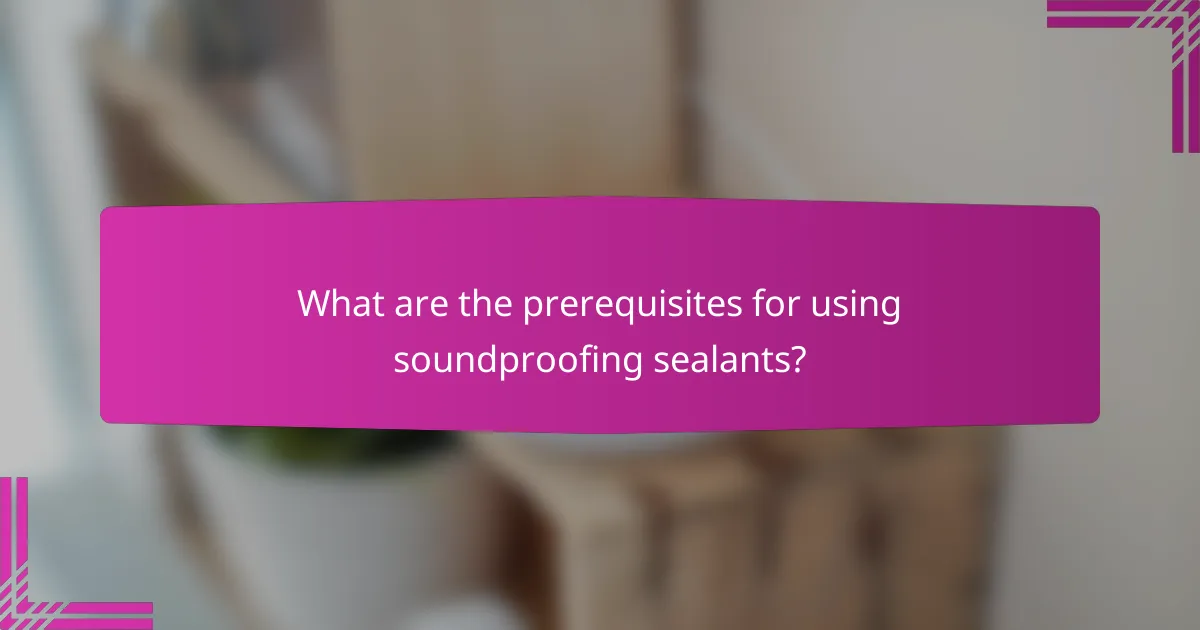
What are the prerequisites for using soundproofing sealants?
Before applying soundproofing sealants, ensure that surfaces are clean, dry, and free from contaminants. Proper surface preparation is crucial for achieving optimal adhesion and effectiveness in noise reduction.
Understanding Noise Sources
Noise sources can be classified into airborne and impact noises. Airborne noise includes sounds from voices, music, or traffic, while impact noise arises from physical activities like footsteps or dropped objects. Identifying these sources helps in selecting the right sealant and application method.
Common airborne noise frequencies range from 125 Hz to 4 kHz, while impact noise typically falls within lower frequencies. Understanding these characteristics allows for better soundproofing strategies, including the use of specific sealants designed to target these frequencies.
Identifying Vulnerable Areas
Vulnerable areas in a building often include gaps around windows, doors, electrical outlets, and wall joints. These openings can significantly compromise soundproofing efforts, allowing noise to penetrate. Inspecting these areas thoroughly is essential before applying sealants.
To effectively identify vulnerable spots, conduct a visual inspection and use a flashlight to spot light leaks. Pay attention to areas where two different materials meet, as these joints are often weak points for sound transmission. Sealing these gaps can lead to noticeable improvements in sound insulation.
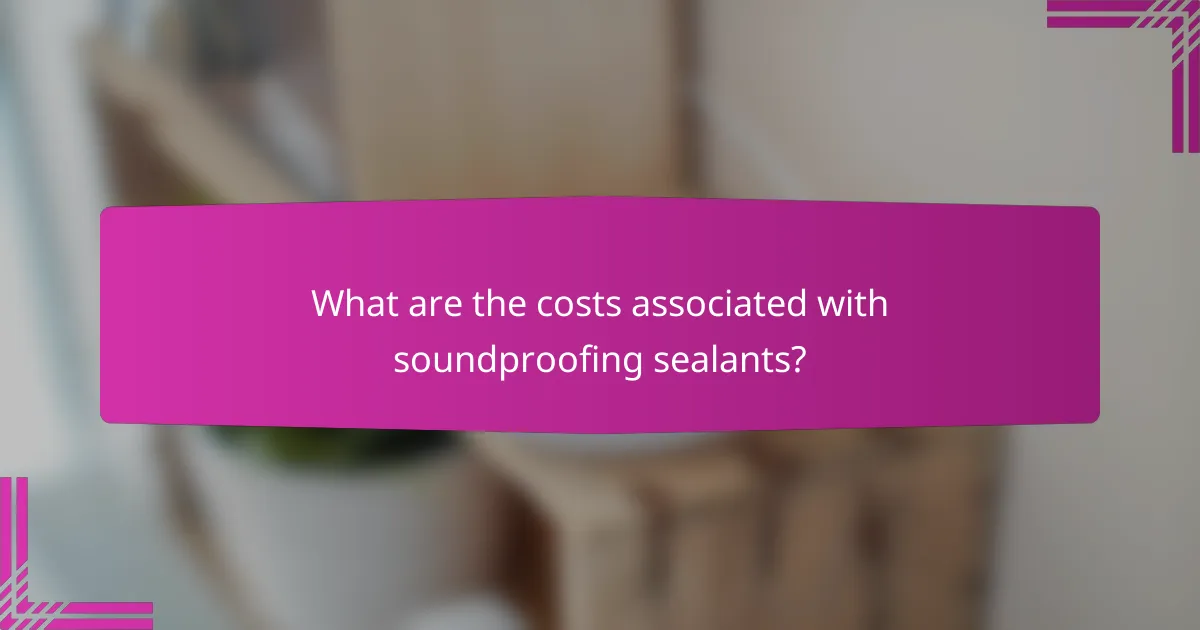
What are the costs associated with soundproofing sealants?
The costs associated with soundproofing sealants can vary widely based on material type, application method, and project scale. Typically, homeowners can expect to spend anywhere from a few dollars to over twenty dollars per tube, depending on the sealant’s quality and effectiveness.
Material Costs
Material costs for soundproofing sealants generally range from around 5 USD to 25 USD per tube. Common types include acrylic, silicone, and polyurethane sealants, each offering different levels of sound attenuation and durability. For larger projects, purchasing in bulk may lead to significant savings.
When selecting a sealant, consider its soundproofing rating, which indicates its effectiveness in reducing noise transmission. Higher-rated sealants may cost more upfront but can provide better long-term value by improving overall sound insulation.
Additionally, factor in any necessary tools or accessories, such as caulking guns or applicators, which can add to the overall cost. Investing in quality tools can enhance application precision and efficiency, ultimately leading to better results in soundproofing.

